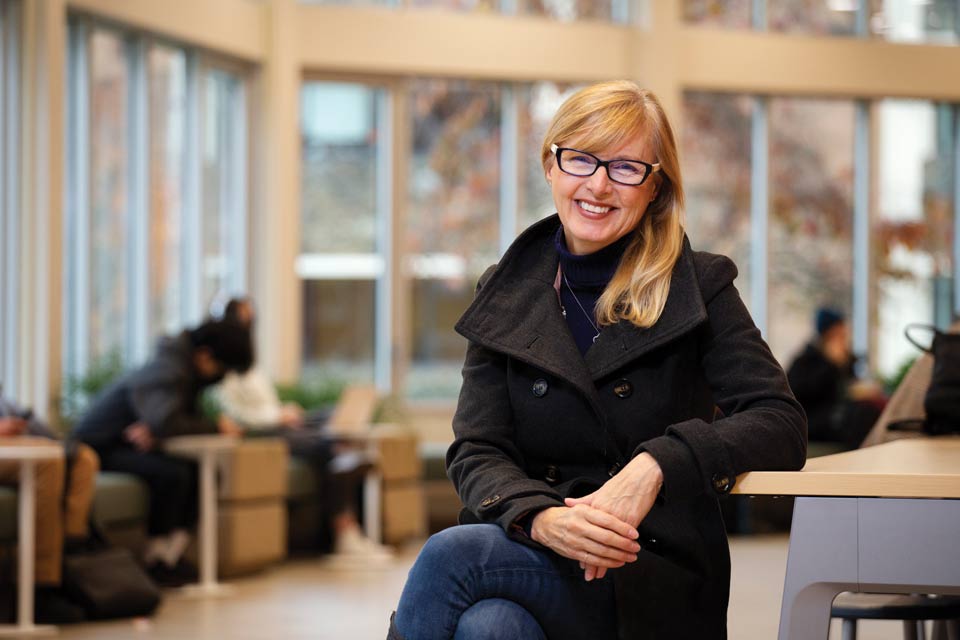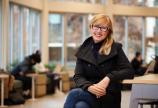Day in the Life: Kim Fawthorpe
- Mitch Wright

If you’ve taken a seat anywhere on the University of Victoria campus, you’ve benefited from the work of Kim Fawthorpe and her team.
Fawthorpe is manager of Interior Modification Services in Facilities Management, where she and her team of five interior designers look after all the furniture and interior design needs on campus—from outfitting a new space to remodelling and updating a previously used facility. Her team also includes two drafting design technicians who look after wayfinding signage on campus and maintain accurate space records for every building and room on campus.
The team also ensures specific ergonomic and functional needs are accommodated, provides desks and chairs for classrooms and exam setups, and works to ensure a barrier-free experience across campus.
At any one time, the team might be working on 200 to 300 projects, ranging in scope from a few hundred dollars to well into the millions. And every piece of furniture they bring on campus is of the highest quality—commercial grade and sustainably created.
“We’re a very busy, very active group,” Fawthorpe says, adding that beyond general day-to-day furniture requests, her team’s work is widely varied with everything from active involvement in decommissioning and recommissioning Level 2 laboratories, to more recently establishing COVID-19 testing clinics.
“COVID hit us quite hard—hit everyone on the front lines of facilities,” Fawthorpe says, highlighting that establishing clinic spaces required an immediate response with very little lead time.
While many university staff were able to shift to a work-from-home situation during the height of the pandemic’s early days, the interior team continued with a hybrid model while working on campus. And all those people working from home presented new challenges, as many now required furniture to outfit their home workspaces.
“That was a very unique experience for me,” says Fawthorpe. “I’ve never encountered anything quite so challenging, with the amount of work we had to do and then undo, and all very quickly. The last year and a half, I’ve felt more like an air-traffic controller.”
Fawthorpe also has to ensure campus is barrier-free. That encompasses things like ramps or chair lifts, handrails, signage and lighting, but may also include designing specific spaces for students with disabilities, creating respite rooms for students and caregivers, and ensuring people can find their way around as well as in and out of facilities.
“It’s all about feeling safe and comfortable and welcome,” says Fawthorpe. “That’s a lot of what my team does every day. We find when we focus on what students need, everything else falls into place.”
Her own favourite place on campus is on the third floor of the McPherson Library, where her team designed a new study space with natural daylighting and comfortable furniture.
“It’s not the biggest or most special, it’s just a really beautiful space. Every time I go there I take a few minutes to enjoy it,” says Fawthorpe, who also spends a sizable portion of her time at home revamping spaces. She’s currently amidst her seventh home restoration, for which she does much of the work herself.
With her team, which she describes as exceptional, Fawthorpe has twice received special recognition—the 2009 President’s Distinguished Service Award (for the William C. Mearns Centre for Learning team) and the 2019 President’s Extraordinary Service Award (Team Cultivator Award for the Surplus Furniture Program).
That surplus furniture program was launched a few years after Fawthorpe began at UVic in 2003, when she saw an opportunity to warehouse assets as they became surplus, sell them at a discount and reinvest the proceeds into both maintaining the program and refurbishing student spaces. Those funds have brought five refurbishments to life so far.
The surplus program processed about 100 items in its first year, and now takes in thousands of items annually. The direct impacts of not purchasing new furniture due to the program include avoiding 65 tonnes of CO2 emissions from transport and manufacturing, and saving the institution an estimated $2.5 million to date.

